
Felice Ficherelli
c. 1640–1645
Oil on canvas, 104 x 80.5 cm.
Private collection, Italy
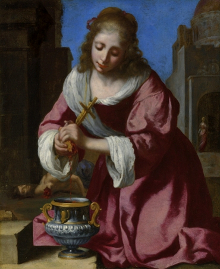
(attributed to Johannes Vermeer)
1655
Oil on canvas, 101.6 x 82.6 cm.
Kufu Company Inc., on long-term loan to the National Museum of Western Art, Tokyo
For nearly 200 years after his death in 1675, no one knew the extent of Vermeer's oeuvre. A few connoisseurs in the Netherlands maintained continuous contact with some of his flagship paintings but, by the end of the eighteenth century, many of Vermeer's other works remained hidden or were attributed to another painter. By the 1850s, however, the French art critic, Etienne J. Théophile Thorè (more publicly known as William Burger, the pseudonym he adopted in 1855 during his political exile from France and retained until the end of his life) had launched a formidable campaign to locate Vermeer's work. Despite an obsessive desire to establish the artistic identity of what he dubbed the "Sphinx of Delft," Thorè- Bürger's search was especially hindered by the mutable character of Vermeer's style.
The range of Vermeer's style and his technique is extraordinary. The relatively thick impastos of the View of Delft and The Milkmaid contrast sharply with the thinly applied glazes of the Woman in Blue Reading a Letter or the Girl with a Wine Glass. And the highly blended contours of the Woman Holding a Balance and the Girl with the Pearl Earring contrapose the flat, relatively unblended tonal shapes of The Lacemaker. Moreover, Vermeer's themes have a desultory aspect, jumping from landscapes to tronies, from letter writers and readers to musical theatre. Further, the Delft Master appears to have dated only one of his paintings (The Procuress in 1656) while using a variety of signature formats.
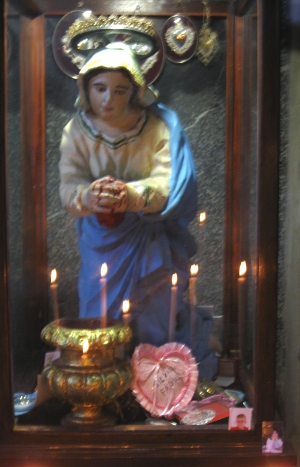
All of these factors, combined with the dispersal of Vermeer's paintings over time after his death, presented experts with a most difficult task of attempting to authenticate (and date) Vermeer's work. Consequently, by 1866, when Thorè-Bürger formally brought Vermeer to the attention of readers of Paris' Gazette des Beaux Arts in three articles which later became a book, he gave Vermeer credit for more than seventy paintings. Clearly, in an effort to be inclusive, he had cast his net far too widely, though Thorè-Bürger did succeed in defining the stylistic, thematic contours of Vermeer's oeuvre.
Over the next century scholars significantly winnowed the paintings attributed to Vermeer. In 1948, Arie Bob de Vries, in the wake of prominent Vermeer forgeries, established the first modern consensus, reducing the total from forty-three and crediting Vermeer with a now familiar thirty-five. Four years later, in his influential book, Vermeer, Lawrence Gowing set the standard which is followed to this day of not listing rejected works. The pruning of Vermeer attributions continued until 1975, culminating with Albert Blankert's book, Johannes Vermeer van Delft 1632–1675, in which he was perhaps too censorious (he proposed eliminating, for altogether unconvincing reasons, the Girl with the Red Hat, Girl Interrupted at her Music, and Woman with a Lute, though he was persuasive in downgrading the National Gallery's Young Girl with a Flute).
On the other hand Vermeer specialists acknowledge there are at least six paintings described by seventeenth- and eighteenth-century sources that cannot be accounted for today, and these phantom Vermeers haunt the art world. The possibility that a new Vermeer could arrive upon the scene reinforces the mystery and intrigue of the artist while, at the same time, raising the stakes for various academics, museums, and publications.
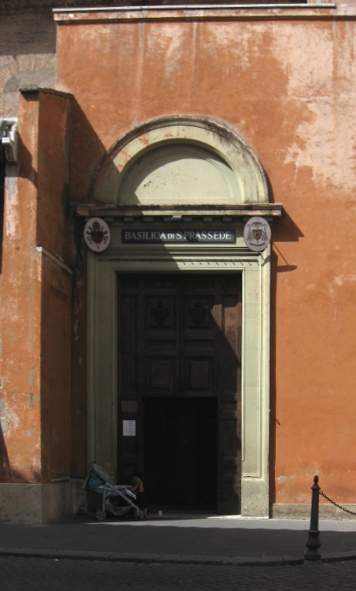
For a fascinating account of the process which modern experts and institutions engage to authenticate works by Vermeer, see the first chapter—"Problems"—in Ivan Gaskell's recent book, Vermeer's Wager: Speculations on Art History, Theory and Art Museums. Here Gaskell outlines the "bewildering mixture of high scholarship and dealers,' collectors,' and publishers' maneuverings to accompany … discovery." He notes the difficulty inherent in Vermeer scholarship because there are so few historical facts to which Vermeer's paintings can be compared and evaluated. As a result, "Highly skilled scholars are tempted to draw inferences from what little there is. For example, from the fact that Vermeer corrected his name in two legal documents, Albert Blankert suggested he was obsessed with precision, drawing a parallel with the paintings themselves." Flimsy evidence indeed. Moreover, Gaskell shows that much other critical analysis of Vermeer "turns out to be no more than free association and fantasy."
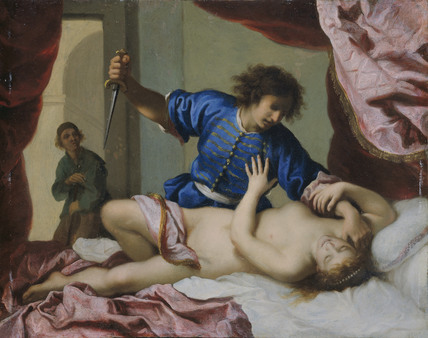
Felice Ficherelli
Late 1630s
Oil on copper, 24.5 x 29.9 cm.
Wallace Collection, London
In recent years only one new painting has been seriously proposed as an addition to Vermeer's canon: Saint Praxedis (fig. 2), a virtual duplicate of an original 1645 painting (fig. 1) of the same name by the Florentine painter, Felice Ficherelli, whose nickname was il Riposo. Saint Praxedis was a second-century Roman Christian who, along with her sister, Pudentiana, cared for the often-severed bodies of those martyred for their faith. By the late sixteenth century she was especially revered by the Jesuits, an order which lived next door to Vermeer's mother-in-law, Maria Thins, along the Oude Langendijk in Delft. After the painting appeared in a 1969 show at the Metropolitan Museum in New York, Michael Kitson, an art historian with the University of London, endorsed its very tentative attribution to Vermeer. But his recommendation became much more meaningful when, in 1986, the curator of Northern Baroque painting at the USA's National Gallery of Art, Arthur K. Wheelock Jr., gave his imprimatur. During the heralded Vermeer exhibit held in Washington D.C. and The Hague in 1995–1996, Wheelock displayed Saint Praxedis prominently; it shared an opening room with Vermeer's two large early history paintings, Diana and her Companions and Christ in the House of Mary and Martha.
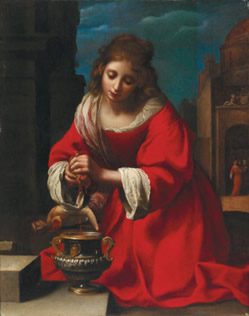
Felice Ficherelli
oil on canvas, 115 x 90 cm. (framed)
Private collection
Based on a recently performed technical analysis, the Dorotheum auction house holds that the above variant of Saint Praxedis appears to be the prime version of the composition on which both the presumed copy by the young Vermeer as well as an autograph version which is now in a private collection in Ferrara (formerly in the collection of Carlo del Bravo in Florence). Both the presumed copy by Vermeer and the Ferrara version, which has been widely considered to be the prototype and the model for Vermeer’s painting, were exhibited recently in Rome. However, it is possible that another version of the composition might have served as the actual model. Detailed information about the Dorotheum variant can be accessed at the auction house's website.
While a number of other scholars were skeptical about the attribution, Wheelock remained resolute in his belief about its authenticity. He marshaled both direct and inferential evidence to support his claim. First, he noted that the painting had, very unusually, two Meer signatures: at the lower left was the name "Meer," with the date "1655." At the lower right edge, there appeared the word "Meer," followed by the letter "N," the letter "R," then two lower case "O's." Wheelock claimed that both "signatures and the date are integral to the paint surface." Further he argued that the second signature could be interpreted as: v[Ver]Meer N[aar] R[ip] o [s] o" or "Vermeer after Riposo," Ficherelli's Italian nickname.
Next, he showed from a laboratory analysis that the paint layers were consistent with seventeenth-century Dutch artistic practices, including those of Vermeer. He made favorable technical and stylistic comparisons with Vermeer's two early history paintings. He noted especially when correlating with Diana and her Companions the similarity of technique "used to paint the deep blue sky: Vermeer, perhaps following the lead of Ficherelli, executed both skies in an unusual manner for a Dutch artist—natural ultramarine laid over a dark imprimatura layer."
Finally, Wheelock called attention to what he believed was the essentially Dutch character of the modeling of Saint Praxedis' face, so resembling other women in Vermeer's paintings, noticeably A Woman Asleep.
During and after the Washington D.C./The Hague show, critics assailed Wheelock's rationale. In the process they disproved his direct evidence and persuasively challenged his inferences. Today, Wheelock stands virtually alone in maintaining the attribution.
Perhaps Jørgen Wadum, the chief curator of the Mauritshuis, conducted the most compelling critical scrutiny of the painting. On the authenticity of the signatures in Saint Praxedis, he demonstrated that the "Meer 1655" inscription was added after the original paint layer had begun to wear away, making it "not integral to the painting." In short, it was added after the painting had been completed. As for the second signature's allusion to Riposo, he, along with virtually all other scholars, thought that "any interpretation would be facetious." Indeed, when Saint Praxedis was examined by Marten Jan Bok, a specialist on the seventeenth-century Utrecht painter Johannes van der Meer, he could not even see the second inscription. Moreover, he would not agree with Wheelock's interpretation about the allusion to Riposo, retorting that "Nowhere in seventeenth-century Dutch painting will you find such an inscription on a copied painting."
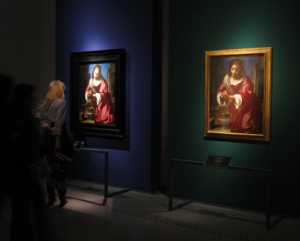
In a point-by-point comparative analysis of style, technique, and painterly application, Wadum disputed Wheelock's evidence. He contrasted the brushwork of Saint Praxedis with that found in both Vermeer's Diana and Christ in the House of Mary and Martha, showing how different it was in the former painting. He examined both the application and sequence of painting methodology and found substantial dissimilarities in Saint Praxedis when compared with Vermeer's other paintings. And while he agreed that the paints came from the seventeenth century, he detected no smalt in Saint Praxedis while both Christ in the House of Mary and Martha and the Diana had significant amounts of smalt. Finally, he flatly debunked one of Wheelock's evidentiary linchpins: When the Mauritshuis staff recently cleaned Diana and her Companions, the procedure revealed that the "deep blue sky" seen in countless reproductions of the painting over the years was really an addition painted over in the 19th century. In truth, the Diana has no substantial painterly affinity with Saint Praxedis.
Wadum's conclusions echoed throughout the world of Vermeer scholarship. Harvard's Ivan Gaskell had written earlier "that as a result of, first, examining the painting while exhibited in Washington (scarcely optimal conditions) in conjunction with Vermeer's two early history paintings, secondly, of discussing the work with specialist colleagues, and, thirdly, reviewing the published arguments, I feel unable to accept an unqualified attribution of Saint Praxedis to Vermeer.v
The Metropolitan Museum of Art's Walter Liedtke opined: "In my view the Saint Praxedis attributed to Vermeer (but widely doubted) is probably Florentine." The Mauritshuis' Ben Broos, after reviewing the history of fraud, forgery, and incompetent attributions that plagued Vermeer's oeuvre in the 20th century, wrote:
Oddly enough, history has recently repeated itself. It happened in 1981, when Arthur K. Wheelock Jr. discovered Saint Praxedis. "The moment I saw her something clicked," says Wheelock. vMy reaction was immediate. It wasn't the signature. On something like that, you just don't trust the signature ….v And indeed, the signature at lower left in the painting's present state is not authentic, and the translation on the right, "Meer naar Riposo" seems "wishful thinking" at best. In my opinion, Saint Praxedis is the latest wrongly attributed Vermeer of the caliber of Van der Laan and Vrel.
Other experts such as Albert Blankert, Gregor J. M. Weber, and the National Gallery in London's Christopher Brown have arrived at similar conclusions. While the science of attribution is not in the final analysis a popularity contest, it does ultimately involve passing tests of empirical evidence. Such tests disprove the case for the Saint Praxedis attribution to Vermeer, making it but one more failed hypothesis. Consequently, over time, later volumes on Vermeer will simply exclude Saint Praxedis, perhaps adding instead an obscure footnote relating the story much in the way Walter Liedtke has already done both in his book, View of Delft, and in his catalog for the recent Vermeer and the Delft School exhibition in New York and London.
In looking at Saint Praxedis one does have a hard time understanding its attribution to Vermeer. It is a second-rate copy of a mediocre painting by an undistinguished artist, with certain features—such as the awkward wrap-around hands—antithetical to Vermeer's sensibility as well as his draftsmanship. While the face itself is beautiful, certainly more charming than that of the original, it is still a facsimile face, a close copy of the source. The theme of the painting is fussy and contrived, way over the top of Vermeer's burlesque Allegory of Faith; even as a very young painter, Vermeer seemed loathe to engage in such simple narrative. Because of the lacuna of detailed historical context surrounding Vermeer, there may have been an overwhelming unconscious temptation to fill it with more complete and satisfying explanations about Vermeer's religion, while lending more substantial support to questionable notions of his Italianate stylistic origins. Whatever the reasons, the Saint Praxedis attribution is severely strained, failing the standard of Ockham's razor: The simplest explanation covering all the facts of the case is that the painting is a copy executed either by the original painter, Ficherelli, in Florence, or by another artist in Ficherelli's circle. The later signatures on the painting likely refer to one or several of the many artists at the time with the name of Meer or van der Meer, not Johannes Vermeer of Delft.
Presently, the overwhelming consensus among Vermeer scholars suggests that thirty-four of the artist's works have survived. A probable thirty-fifth, the Young Girl with the Flute in the USA's National Gallery, was likely begun by Vermeer but finished or restored rather incompetently by another's hand. The painting lacks Vermeer's characteristic virtuosity. (For a good account of this issue, see Arthur K. Wheelock Jr.'s Washington/The Hague exhibition catalog, pages 204–207.) Given the recent episode with the Saint Praxedis misattribution, given the longer history of other such round-hole, square-peg efforts, and given the possibility that previously undiscovered Vermeer's may emerge, Vermeer's canon will likely encounter continued challenges.
Jon Boone
July 11, 2002